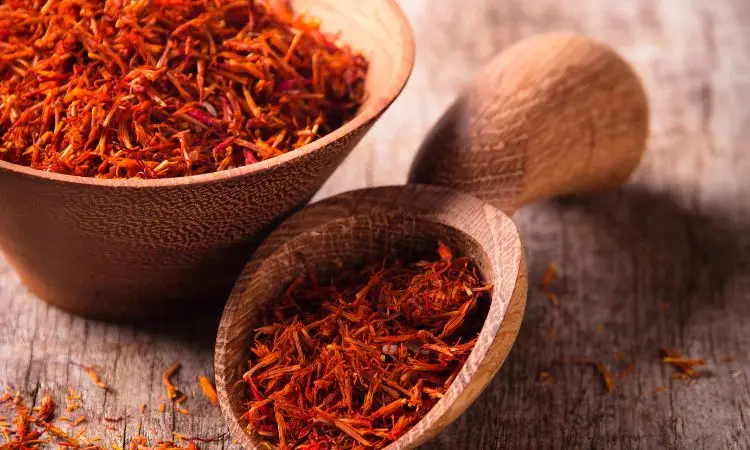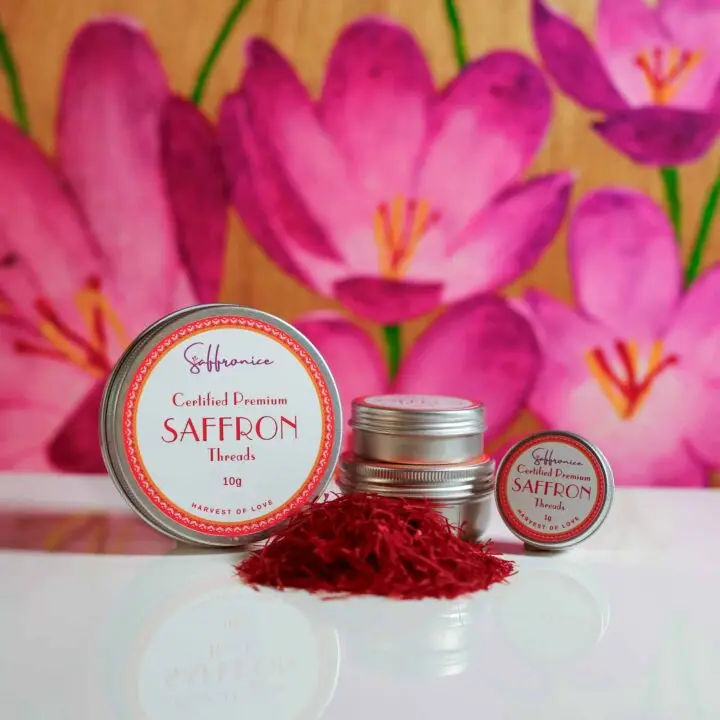Ever thought about how to make your cooking better with saffron? This special spice comes from the delicate Crocus sativus flower. It has been a favorite in kitchens for over 3,500 years, adding a unique taste to dishes.
The real magic happens when you mix saffron with other spices and ingredients. This creates a perfect blend of flavors. Discover the secrets of saffron and start a journey of amazing tastes.
Key Takeaways
- Saffron is one of the world’s most expensive spices, with its labor-intensive production making it a rare and valuable culinary treasure.
- Careful measurement and preparation techniques, such as blooming saffron in warm liquids, are essential to maximize its complex flavor profile.
- Saffron’s versatility allows it to pair beautifully with a wide range of ingredients, from rice and seafood to poultry and desserts.
- Pairing saffron with complementary spices like cardamom, cinnamon, and cloves can create layers of depth and complexity in your dishes.
- Understanding the temperature sensitivity of saffron and when to add it to your recipes is key to preserving its aromatic qualities.
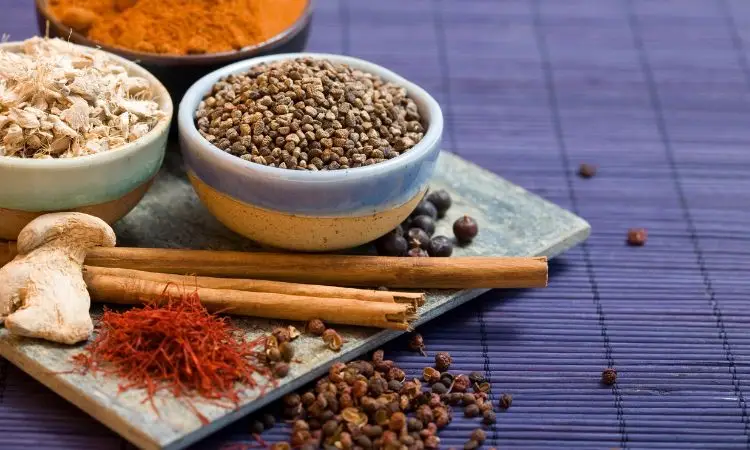
Understanding Saffron’s Unique Profile and Characteristics
Saffron is the world’s most expensive spice, loved for its rich history and cultural value. It’s harvested from the Crocus sativus flower in autumn. Each flower has only three precious threads.
The Origins and Cultural Significance of Saffron
Saffron is seen as a symbol of luxury and sophistication. It comes from ancient Persia and the Mediterranean. It’s used in cooking, medicine, fragrance, and as a natural dye.
Its deep red color has spiritual and religious importance in many cultures. This makes it a key ingredient in ceremonies and rituals.
Key Flavor Components in Saffron
Saffron’s flavor is unique, with floral, honey-like, and earthy notes. Its sweetness is like honey or hay. The earthy tones are similar to mushrooms or aromatic woods.
A hint of bitterness balances the spice’s floral aromas. This creates a complex and captivating flavor.
Quality Indicators for Selecting Saffron
When buying saffron, look for whole, vibrant red threads. Avoid any yellow or white parts, as they’re not of high quality. Genuine saffron should have a strong aroma and intense color.
For the best quality, choose saffron from places like Kashmir, Iran, Spain, Greece, and Italy. These areas have the best farming practices and conditions.
Essential Techniques for Preparing Saffron
Saffron, known as the “red gold,” needs careful preparation to bring out its flavor and aroma. It comes from Asia Minor and is famous for its health benefits. These include fighting depression and boosting the immune system with its high vitamin C.
To prepare saffron, you must bloom it. This means soaking the threads in warm liquid for 10-15 minutes. This step lets the flavors and colors mix into the dish. Paella experts suggest using 1 gram of saffron for every 250 ml of liquid.
Another method is to grind saffron into a fine powder. This can make the flavor stronger and easier to mix into recipes. But, remember, too much saffron can overpower a dish. A good amount is about 100 ml of saffron infusion, enough for 2 to 4 people.
Saffron doesn’t like high heat, so add it late in cooking. You can also try cold infusion for dishes that are served chilled. Letting the infusion sit for a few minutes can make the flavors even more intense.
Whether using threads or ground saffron, the goal is to find the right balance. This lets the unique, earthy-floral taste of saffron shine. With the right preparation, saffron can make any dish, from paella to rice pilafs, truly special.
Classic Saffron Spice Pairing Combinations
Saffron is the world’s most expensive spice, known for its floral aroma and golden color. It’s loved in the Mediterranean, Middle East, and India for its unique taste. Each place uses it in different ways, making it special.
Traditional Mediterranean Pairings
In the Mediterranean, saffron is key in dishes like paella and risotto. It adds a rich flavor that goes well with seafood. Saffron also makes rice dishes creamy and flavorful.
Middle Eastern Flavor Combinations
In the Middle East, saffron makes spice blends even more aromatic. It pairs well with cardamom, cinnamon, and clove in curries and biryanis. This spice also balances the richness of lamb and yogurt.
Indian Culinary Partnerships
In India, saffron is used in both savory and sweet dishes. It adds a golden color and a unique aroma. Saffron is found in basmati rice, creamy curries, and desserts like kheer and kulfi.
| Beef and Saffron Pairings | Chicken and Saffron Pairings | Seafood and Saffron Pairings | Pork and Saffron Pairings |
|---|---|---|---|
|
|
|
|
These recipes show how saffron pairs well with many ingredients. It adds a floral touch and a hint of bitterness to dishes. Saffron makes food in the Mediterranean, Middle East, and India even more special.
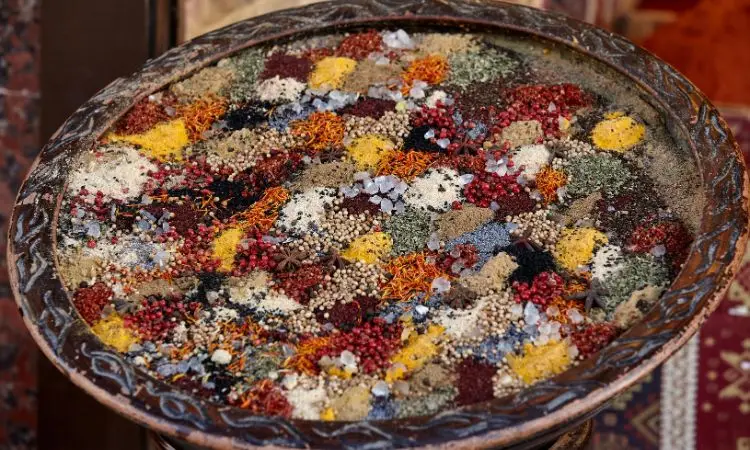
Blooming and Extraction Methods for Maximum Flavor
Discover how to bring out the best in saffron’s aroma and taste. Mastering blooming and extraction techniques can make your saffron dishes truly special. They add a depth of flavor that will amaze you.
Blooming Saffron: Releasing the Essence
Blooming saffron is key to unlocking its vibrant flavor and color. Soak the delicate threads in warm liquid like water, broth, or milk for 10-15 minutes. This process lets the saffron’s compounds fully release, making a golden liquid perfect for your recipes.
Try different liquids and temperatures to see how they change the flavor. Warm milk can add a sweet touch, while broth gives a savory taste. Adjust the steeping time for stronger flavors.
Saffron Extraction: Unlocking the Bioactive Compounds
There’s more to saffron than just blooming. New extraction methods like ultrasonic, supercritical fluid, and microwave-assisted can extract more flavor and health benefits. These methods help get more of the important compounds like crocin, crocetin, and safranal.
| Extraction Method | Key Benefits |
|---|---|
| Ultrasonic Extraction | Increased yield, reduced extraction time, and enhanced bioactive compound recovery |
| Supercritical Fluid Extraction | Eco-friendly, high purity, and selective isolation of target compounds |
| Microwave-Assisted Extraction | Faster extraction, lower solvent consumption, and improved antioxidant activity |
Using these advanced techniques, you can get the most out of saffron. This means better flavor and health benefits for your dishes. Your guests will love the unique taste and aroma.
Warm Spices That Complement Saffron
Finding the right flavors to match saffron is key. Warm spices like cardamom, cinnamon, nutmeg, and cloves are perfect. They create a blend that’s both harmonious and captivating.
Cardamom and Cinnamon Synergy
Cardamom and cinnamon pair well with saffron. Cardamom’s floral notes match saffron’s earthy taste. Cinnamon adds warmth and depth. Together, they’re amazing in Persian rice dishes.
Nutmeg and Clove Combinations
Nutmeg and clove add richness to saffron. Nutmeg’s sweetness enhances saffron’s musky flavor. Clove’s aroma balances it out. They’re great in stews, curries, and baked goods.
Exploring warm spice pairings opens up new possibilities for saffron dishes. From cardamom and cinnamon to nutmeg and clove, these flavors will delight your taste buds. Start your saffron spice blending journey with these essential spices.
Discover more about the art of pairing saffron with other spices for unforgettable dishes.
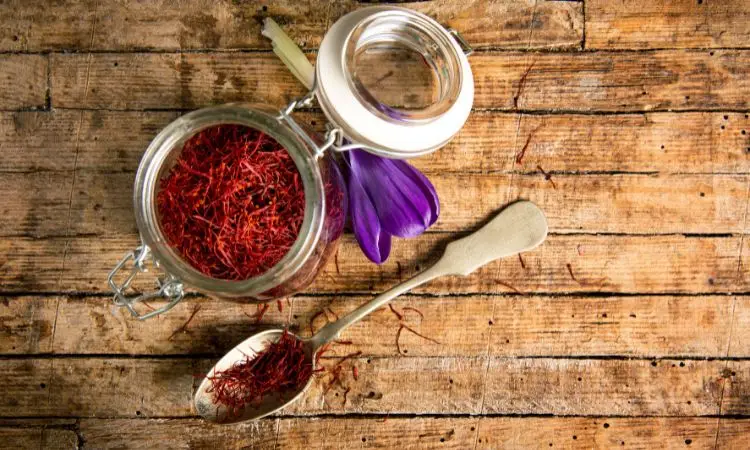
Herbs and Fresh Ingredients for Saffron Enhancement
Pairing saffron with fresh herbs is a culinary dream. Herbs like parsley, cilantro, and basil bring out saffron’s unique taste. They add a bright, lively touch. 🌿
Adding saffron to dressings and sauces can make simple dishes stand out. Try saffron-infused vinaigrettes or creamy sauces. Let the saffron infuse slowly to release its full flavor. 🍴
Exploring different cuisines opens up new ways to use saffron. From Mediterranean herbs to Middle Eastern spices, saffron’s uses are endless. 🌍
- Pair saffron with fresh herbs like parsley, cilantro, and basil for a vibrant flavor boost.
- Incorporate saffron into dressings, sauces, and marinades to infuse dishes with its unique essence.
- Experiment with global flavor combinations to discover new ways to showcase saffron’s versatility.
When using saffron, a little is enough. Use roughly 20 threads for each pinch (~1/16th tsp) of saffron powder called for in recipes. Steeping saffron in hot, acidic, or alcoholic liquids for 20 minutes enhances flavor. 🧪
“Saffron pairs beautifully with flavors such as almonds, cardamom, rosemary, thyme, and basil, elevating the overall profile of your dish.”
Mastering saffron pairings opens up a world of flavors. You’ll create truly unforgettable dishes. 🌶️
Temperature Considerations When Cooking with Saffron
Temperature is key to bringing out saffron’s full flavor. It changes how the spice tastes in hot and cold dishes. This lets you adjust its flavor in your cooking.
Hot Infusion Techniques
To get saffron’s flavor fast, add it to warm liquids like broths or oils. This hot infusion method quickly brings out its taste and color. It’s perfect for dishes like risottos, paellas, and stews that need a strong saffron flavor.
Cold Steeping Methods
For a softer saffron taste, use cold steeping. Let the strands soak in cold water or broth for hours or overnight. This method is great for dishes like seafood, rice pilafs, and baked goods, where a gentle saffron flavor is desired.
| Infusion Method | Flavor Impact | Best Suited For |
|---|---|---|
| Hot Infusion | Bold, immediate saffron punch | Risottos, paellas, stews |
| Cold Steeping | Delicate, nuanced saffron notes | Seafood dishes, rice pilafs, baked goods |
Knowing how temperature affects saffron’s taste opens up new cooking possibilities. You can make dishes that truly highlight this precious spice.
Creating Balanced Flavor Profiles with Saffron
Mastering saffron pairing is all about finding the right mix of ingredients. Saffron’s unique taste can be boosted or toned down by choosing the right partners. By knowing how saffron works with other spices, we open up a world of flavors.
To make saffron dishes pop, add a splash of lemon juice or vinegar. These bright, tangy flavors lift saffron’s taste without drowning it. Mixing saffron with spices like cardamom, cinnamon, or ginger creates rich, balanced flavors.
For a bold twist, try saffron in sweet and savory dishes. It’s amazing in desserts like ice cream or baked goods. This shows saffron’s ability to make unforgettable, well-balanced meals.
Recommended Saffron Spice Pairings
- Saffron and cardamom: A classic Middle Eastern and South Asian combination
- Saffron and cinnamon: Popular in pastries and hot beverages
- Saffron and ginger: Ideal for marinades, soups, and stews
- Saffron and turmeric: Elevates rice dishes and curries
- Saffron and rose: Suitable for desserts and specialty drinks
- Saffron and citrus: Enhances seafood, salads, and sauces
- Saffron and Vanilla: Commonly used in ice cream and baked goods
When making your own saffron blends, start small and pick flavors that go well together. Be ready to tweak until you get the perfect mix. The effort is worth it for the amazing flavors you can create.
Advanced Saffron Pairing Techniques for Professional Results
To make saffron dishes truly stand out, chefs need to master advanced pairing techniques. Mark Sullivan and others have perfected the art of bringing out saffron’s full flavor. They do this by toasting spices first, which releases their aroma and blends with saffron beautifully.
Chefs also like to try new and exciting pairings, like saffron with lavender or exotic fruits. These unique combinations can take diners on a thrilling taste journey. By bruising herbs and making herb-infused sauces, chefs can enhance saffron’s flavors, making dishes more engaging.
Learning these advanced techniques is key to culinary greatness. It involves toasting spices, trying new pairings, and using special methods to extract flavors. These steps lead to dishes that are rich and complex. For those aiming to create truly memorable saffron dishes, these methods are essential.
FAQ
What is saffron and what makes it a prized ingredient?
Saffron comes from Crocus sativus flowers and has a rich history of over 3,500 years. It’s known for its unique taste, smell, and color. This makes it very popular in cooking and perfumery.
How is saffron cultivated and harvested?
Saffron has been grown for thousands of years and is seen as a luxury. It’s picked from Crocus sativus flowers in autumn. Each flower only has three stigmas, making it very hard to harvest.
What are the key flavor components of saffron?
Saffron tastes floral, honey-like, and earthy. It’s a versatile ingredient used in many cuisines and perfumes.
How should saffron be prepared for maximum flavor and aroma?
To get the most out of saffron, it needs to be prepared right. Soak the threads in warm liquid for 10-15 minutes. Grinding it into a fine powder can also boost its flavor. But be careful not to use too much, as it can overpower a dish.
What are some classic saffron spice pairing combinations?
Saffron goes well with rice, seafood, and poultry. In Mediterranean dishes, it’s key in paella and risotto. In Middle Eastern cooking, it’s mixed with spices like cardamom and cinnamon for curries and biryanis. Indian recipes use saffron in both savory and sweet dishes.
How do temperature and infusion methods affect saffron’s flavor?
The temperature affects how saffron’s flavor and color are released. Hot liquids quickly bring out their properties. Cold steeping, like overnight in cold water, can make the flavors more delicate.
How can saffron be balanced with other ingredients for optimal flavor?
To balance saffron’s taste, choose ingredients that complement it. Acidic things like lemon juice or vinegar can enhance its flavor. Mixing saffron with spices creates complex tastes. Trying it in sweet and savory dishes shows its versatility.
What are some advanced techniques for pairing saffron with other ingredients?
For advanced pairing, try toasting spices before mixing with saffron. Also, bruising herbs and making herb-infused sauces can boost flavors. Chefs also try new pairings, like saffron with lavender or exotic fruits, for unique tastes.


